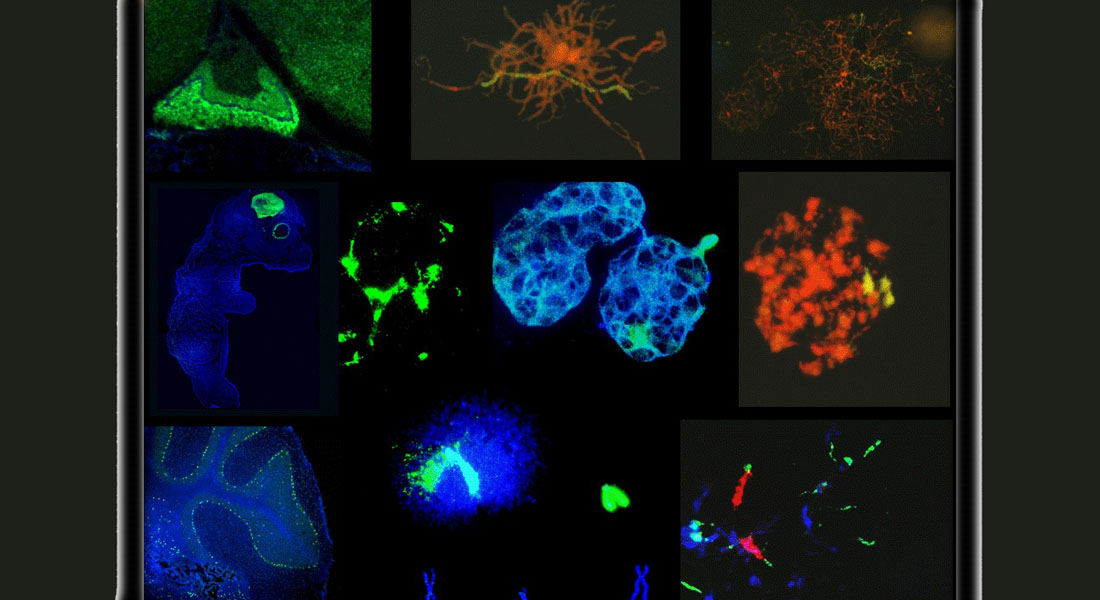Silahtaroglu Group
Silahtaroglu Group has a mechanistic interest into genome-wide and locus specific regulation and fine-tuning of tissue-specific gene expression.

I have a mechanistic interest into genome-wide and locus specific regulation and fine-tuning of tissue-specific gene expression. We are interested in the 3D-organization of genome within the nuclear space, non-coding RNAs and epigenetic modifications especially methylation and hydroxymethylation. The interaction of these linear and 3-dimentional mechanisms in gene regulation within the healthy brain and the neurodegenerative diseases is the primary interest.
For a very long time we have been working on a specific familial balanced translocation t(8;20) segregating with early onset cerebellar ataxi and use this translocation in learning about the organization and the function of the genome around the breakpoints. The synapse associated DLGAP4 gene which spans one of the breakpoints became my favorite gene over the years.
I do not like being limited by the technical short-comings when I need to find answers to biological questions. Therefore, I have a great interest in developing novel methods based on in situ hybridization both at RNA and DNA level, and I try novel probe technologies and develop new nuclear preparation methods in order to study the genome organization by pushing the resolution limits from different sides . We think multidiciplinary projects are always exciting. Over the years, we have been collaborating with DTU Nanotech in developing lab-on-a-chip devices for genetic analyses.
- Is distrupted genomic architecture the cause or the effect in the neurodegenerative diseases? The organization of the genome in territories, domains and loops is essential for normal development and function. This non-random organization provides a new layer of fine transcriptional regulation especially in the brain. The role of spatial genome organization in normal and diseased brain cells is being investigated and it is suggested as a potential tool for presymptomatic diagnosis in neurodegenerative diseases.
- Using a balanced translocation t(8;20) segregating with Early Onset Cerebellar ataxia, we have found DLGAP4 gene at one breakpoint as the candidate for the ataxia phenotype. We are characterizing the function of DLGAP4 and some of the novel non-coding RNAs found in the vicinity of the breakpoints.
- Developing tools for high resolution visual analysis of the genome has always been a great interest. We are working on chromatin spreading techniques in collaboration with Niels Tommerup as well as collaborating with Jesper Wengel, SDU on locked nucleic acid based new probe technologies for possibilities of hybridization without the need for denaturation which is suggested to change the genomic architecture.
- In collaboration with DTU Nanotech, we are developing a work flow for sequencing of long DNA molecules as a supplementary method for next generation sequencing. The method is based on obtaining megabase-sized single DNA Molecules from a specific region of the genome for optical mapping in a nanofluidic device.
60 peer review articles
- Rasmussen AH, Rasmussen HB, Silahtaroglu A. The DLGAP family: neuronal expression, function and role in brain disorders. Mol Brain. 2017 Sep 4;10(1):43.
- Minocherhomji S, Hansen C, Kim HG, Mang Y, Bak M, Guldberg P, Papadopoulos N, Eiberg H, Doh GD, Møllgård K, Hertz JM, Nielsen JE, Ropers HH, Tümer Z, Tommerup N, Kalscheuer VM, Silahtaroglu A. Epigenetic remodelling and dysregulation of DLGAP4 is linked with early-onset cerebellar ataxia. Hum Mol Genet. 2014 Dec 1;23(23):6163-76.
- Minocherhomji S, Seemann S, Mang Y, El-Schich Z, Bak M, Hansen C, Papadopoulos N, Josefsen K, Nielsen H, Gorodkin J, Tommerup N, Silahtaroglu A. Sequence and expression analysis of gaps in human chromosome 20. Nucleic Acids Res. 2012 Aug;40(14):6660-72.
- Silahtaroglu AN, Nolting D, Dyrskjøt L, Berezikov E, Møller M, Tommerup N, Kauppinen S. Detection of microRNAs in frozen tissue sections by fluorescence in situ hybridization using locked nucleic acid probes and tyramide signal amplification. Nat Protoc. 2007;2(10):2520-8.
- Silahtaroglu AN, Tommerup N, Vissing H. FISHing with locked nucleic acids (LNA) :evaluation of different LNA/DNA mixmers. Mol Cell Probes. 2003;17(4):165-9.
- Silahtaroglu A, Stenvang J. MicroRNAs, epigenetics and disease. Essays Biochem. 2010 Sep 20;48(1):165-85.
- Bertelsen B, Melchior L, Jensen LR, Groth C, Glenthøj B, Rizzo R, Debes NM, Skov L, Brøndum-Nielsen K, Paschou P, Silahtaroglu A, Tümer Z. Intragenic deletions affecting two alternative transcripts of the IMMP2L gene in patients with Tourette syndrome. Eur J Hum Genet. 2014 Nov;22(11):1283-9
- Bak M, Silahtaroglu A, Møller M, Christensen M, Rath MF, Skryabin B, Tommerup N, Kauppinen S. MicroRNA expression in the adult mouse central nervous system. RNA. 2008 Mar;14(3):432-44.
- Hecker N, Seemann SE, Silahtaroglu A, Ruzzo WL, Gorodkin J. Associating transcription factors and conserved RNA structures with gene regulation in the human brain. Sci Rep. 2017 Jul 18;7(1):5776.
- Elmén J, Lindow M, Silahtaroglu A, Bak M, Christensen M, Lind-Thomsen A, Hedtjärn M, Hansen JB, Hansen HF, Straarup EM, McCullagh K, Kearney P, Kauppinen S. Antagonism of microRNA-122 in mice by systemically administered LNA-antimiR leads to up-regulation of a large set of predicted target mRNAs in the liver. Nucleic Acids Res. 2008 Mar;36(4):1153-62.
- Hébert SS, Horré K, Nicolaï L, Papadopoulou AS, Mandemakers W, Silahtaroglu AN, Kauppinen S, Delacourte A, De Strooper B. Loss of microRNA cluster miR-29a/b-1 in sporadic Alzheimer's disease correlates with increased BACE1/beta-secretase expression. Proc Natl Acad Sci USA. 2008 Apr 29;105(17):6415-20.
- Sempere LF, Christensen M, Silahtaroglu A, Bak M, Heath CV, Schwartz G, Wells W, Kauppinen S, Cole CN. Altered MicroRNA expression confined to specific epithelial cell subpopulations in breast cancer. Cancer Res. 2007 Dec 15;67(24):11612-20.
- Reisner W, Larsen NB, Silahtaroglu A, Kristensen A, Tommerup N, Tegenfeldt JO, Flyvbjerg H. Single-molecule denaturation mapping of DNA in nanofluidic channels. Proc Natl Acad Sci USA. 2010 Jul 27;107(30):13294-9.
- Makransky G, Bonde MT, Wulff JS, Wandall J, Hood M, Creed PA, Bache I, Silahtaroglu A, Nørremølle A. Simulation based virtual learning environment in medical genetics counseling: an example of bridging the gap between theory and practice in medical education. BMC Med Educ. 2016 Mar 25;16:98.
Film about the project ”Challenges in a multicultural university environment” that is supported by the KU “Education at its Best” initiative. "Det multikulturelle universitetsmiljø" (not available on-line)
_________________________________
Entry to ARTIS (Art in Science) competition 2016, which is chosen for exhibition.
Being Close to the two limits of unknown
This is a composite image showing (on the left), Transit of Venus (small black dot) across the sun (orange) that has taken place on the 6th of June 2012 and (on the right) the center of the X-chromosome (fluorescent signal) within the genome (orange) of an egg cell of a female fetus. The diameter of the sun is about 1000 000 000 000 000 (1015) micrometers. The nucleus of an egg is 10 micrometers in diameter. The ratio between the Venus and the Sun is almost the same as the X-chromosome centromere and the nucleus. Here we show the X-chromosome in the developing egg together with the Venus that always has a female connotation among the planets. The Venus transiting the sun is photographed by Niels Tommerup, the fetal meiotic chromosomes with the fluorescent signal is taken by Asli Silahtaroglu.
 Group Leader
Group Leader
Asli Silahtaroglu
Associate Professor
asli@sund.ku.dk
(+45) 35 32 76 21
CV, publications, etc.
